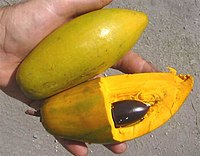Користувач:Roman Popyk/Каністел
| Каністел | |
|---|---|

| |
| Pouteria campechiana | |

| |
| Pouteria campechiana (переріз) | |
| Scientific classification | |
| Царство: | Рослини |
| Надклас: | Покритонасінні |
| Клас: | Еудікоти |
| Підклас: | Айстериди |
| Порядок: | Вересоцвіті |
| Родина: | Сапотові |
| Рід: | Pouteria |
| Вид: | P. campechiana |
| Біноміальна назва | |
| Pouteria campechiana | |
| Синоніми[1] | |
|
Lucuma campechiana Knuth | |

Каністел (лат. Pouteria campechiana) – плодове вічнозелене дерево родини Сапотових.[2] Вирощується в таких країнах, як Коста-Рика, Бразилія, Сполучені Штати, Тайвань, Австралія,[3] В'єтнам, Індонезія, Індія, Шрі-Ланка, Нігерія і Філіпіни. Їстивним є плід, який часто називають "яєчним фруктом".[3]
Каністел росте до 10 метрів вгору, а його оранжево-жовті фрукти, що називаються жовті сапоти – до 7 см в довжину. М'якоть каністела – солодка, з текстурою схожою на яєчний жовток зварений натвердо, звідси і походить розмовна назва – "яєчний фрукт".
Опис плоду[ред. | ред. код]
Форма і розмір плоду відрізняються залежно від сорту. The better selections consistently produce large ovate fruit with glossy skin weighing upwards of 400 grams (14 ounces). The flesh is somewhat pasty, although the best varieties have a creamy mousse-like texture. The flavor is rich and is reminiscent of an egg-custard.[4] The fruit may contain between one and six large brown seeds.
The canistel displays climacteric fruit ripening. A fully mature fruit shows an intense yellow skin color. It will eventually soften and drop from the tree. Insects and birds avoid the fruit flesh, perhaps because of its astringent properties, that are much reduced in senescent fruits, but still perceptible to the human palate. Apparently mature fruits severed from the tree while still hard often fail to develop the desired climacteric changes in terms of reduced astringency and a texture reminiscent of egg yolk. This, and the fact that climacteric fruits quickly start to decay at ambient temperatures, may have contributed to the low economic importance of the canistel.
Використання[ред. | ред. код]
Like the related lucuma, the canistel can be eaten fresh, and has the texture of a hard-boiled egg yolk.[3] The ripe fruit can be made into jam, marmalade, pancakes, and flour.[5] The ripe flesh is blended with milk and other ingredients to make a shake, and pureed it is sometimes added to custards or used in making ice cream.[6] It is also used in a milkshake known as "eggfruit nog".[3]
The wood of the tree is occasionally used in construction where it is available, especially as planks or rafters. In its native range, it has been a source of latex used to adulterate chicle.[6]
Етимологія[ред. | ред. код]
Наукове ім'я каністела походить з батьківщини фрукту – мексиканського міста Кампече.
У багатьох країнах, де він культивується або продається, каністел відомий за багатьма народними назвами; найбільш поширеним є каністел, як варіанти можуть бути яєчний фрукт та назви, що вказують на його жовтий колір.[7] In the Philippines it is called chesa or tiessa or tiesa. In Sri Lanka this fruit is known as Laulu, Lavulu or Lawalu.[5] In Thailand it is known by different traditional popular names such as Lamut Khamen (ละมุดเขมร="Khmer Sapodilla") or Tho Khamen (ท้อเขมร="Khmer Peach"), folk imagination attributing a hypothetical Cambodian origin to this fruit (the name of the fruit is See Da in Cambodia).[8] Currently those names are discouraged by linguistic authorities and names making no reference to Cambodia, such as Mon Khai (ม่อนไข่) —Khai meaning "egg", or Tiesa (ทิสซา), are officially favored.[9]
The plant's name in the Vietnamese language is cây trứng gà ("chicken egg" plant) because of the fruit's appearance. It also has the Vietnamese name lekima. This is unusual because Vietnamese is a tonal, isolating language whose morphemes all consist of a single syllable.
In Indonesian Language it is called alkesah, or sawo mentega (butter sapodilla, for its color and texture).
Though relatively rare in East Africa, they can be found, and in the Swahili language the fruit is confusingly named "zaituni", which is the same word used to refer to olives.
In Taiwan it is called danhuang guo (蛋黃果), "жовтковий фрукт" or xiantao (仙桃) "персик безсмертних".
Галерея[ред. | ред. код]
-
Листки
-
Фрукти на місцевому ринку
-
Різні форми плоду
| {{{name}}} Харчова цінність в 100 г продукту | ||||||||||||
|---|---|---|---|---|---|---|---|---|---|---|---|---|
| Енергетична цінність Задайте ккал або кДж! | ||||||||||||
| ||||||||||||
References[ред. | ред. код]
- ↑ "Pouteria campechiana". Integrated Taxonomic Information System. Retrieved 2014-02-26.
- ↑ Roman Popyk/Каністел: інформація на сайті GRIN
- ↑ а б в г T. K. Lim (2013). Edible Medicinal And Non-Medicinal Plants: Volume 6, Fruits. Springer Science & Business Media. ISBN 9789400756281.
- ↑ Charles Boning (2006). Florida's Best Fruiting Plants: Native and Exotic Trees, Shrubs, and Vines. Sarasota, Florida: Pineapple Press, Inc. с. 53.
- ↑ а б D.K.N.G. Pushpakumara (2007). Lavulu. Underutilized fruit trees in Sri Lanka (PDF). World Agroforestry Centre, South Asia Office, New Delhi, India.
- ↑ а б Julia F. Morton (1987). Canistel. Fruits of Warm Climates. с. 402—405. Процитовано 24 вересня 2010.
- ↑ Tong Kwee Lim (15 February 2013). Edible Medicinal And Non-Medicinal Plants: Volume 6, Fruits. Springer. с. 134. ISBN 978-94-007-5628-1.
- ↑ มีเมล็ดละมุดเขมรหรือเซียนท้อจำหน่าย.
- ↑ 7 Health Benefits of Canistel
External links[ред. | ред. код]
 Вікісховище має мультимедійні дані за темою: Pouteria campechiana
Вікісховище має мультимедійні дані за темою: Pouteria campechiana Таксономія за темою Pouteria campechiana у Віківидах
Таксономія за темою Pouteria campechiana у Віківидах


